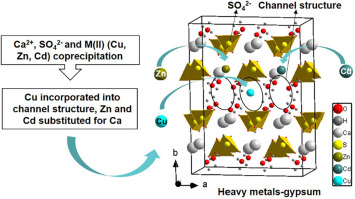当前位置:
X-MOL 学术
›
Chem. Geol.
›
论文详情
Our official English website, www.x-mol.net, welcomes your feedback! (Note: you will need to create a separate account there.)
Incorporation of trace metals Cu, Zn, and Cd into gypsum: Implication on their mobility and fate in natural and anthropogenic environments
Chemical Geology ( IF 3.9 ) Pub Date : 2020-05-01 , DOI: 10.1016/j.chemgeo.2020.119574 Xu Ma , Mario A. Gomez , Zidan Yuan , Ran Bi , Jiaxi Zhang , Shaofeng Wang , Shuhua Yao , Michael Kersten , Yongfeng Jia
Chemical Geology ( IF 3.9 ) Pub Date : 2020-05-01 , DOI: 10.1016/j.chemgeo.2020.119574 Xu Ma , Mario A. Gomez , Zidan Yuan , Ran Bi , Jiaxi Zhang , Shaofeng Wang , Shuhua Yao , Michael Kersten , Yongfeng Jia

|
Abstract The coexistence of calcium (Ca2+), sulfate (SO42−) with trace metal cations (M(II)) can possibly lead to M(II)-gypsum coprecipitation and solid solution formation. However, gypsum's role in the fixation of M(II) is still largely unknown. This study investigated the precipitation of Ca2+ and SO42− in the presence of M(II) (i.e., Cu2+, Zn2+, or Cd2+) and the incorporation of the metal cations into the gypsum structure at different environmental conditions. Trace metals in two natural gypsum samples (Yunnan and Neimeng, China) and one hydrometallurgical byproduct gypsum sample from a Cu refinery were also assessed. X-ray diffraction, scanning electron microscopy-energy dispersive X-ray spectroscopy, and Fourier transform infrared spectroscopy were employed to characterize the solid samples. The lab-scale results showed that the M(II) content in the coprecipitates increased with pH and the initial M(II) concentration. At lower pH, Zn2+ and Cd2+ were dominantly fixed through isomorphic substitution for Ca2+ in the gypsum structure, while Cu2+ was likely incorporated into the channel structure of the gypsum where the water molecules reside. In contrast, at higher pH, thermodynamic modeling results indicated that M(II)-hydroxides and base metal sulfates (Mx(OH)y(SO4)z) were formed and constituted an appreciable fraction of M(II)-bearing species in the host solids. Our study further showed that trace amounts of Cu, Zn, and Cd were also substitutianly incorporated in the two natural and one hydrometallurgical gypsum samples. The present study may have important implications for understanding the geochemical cycle of trace metals in Ca2+ and SO42− coexisting systems, as well as possible attenuation mechanisms that may occur along their supersaturation and coprecipitation.
更新日期:2020-05-01


























 京公网安备 11010802027423号
京公网安备 11010802027423号